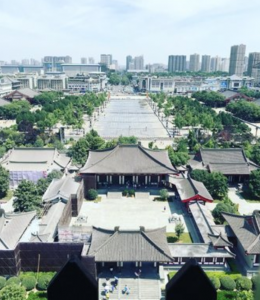 The Big Wild Goose Pagoda is in the Dacien Temple. You must first buy tickets for the temple. As for whether or not to climb the Pagoda, it is all by personal will. This somewhat fat and sturdy geese Pagoda stands alone independently, looks like a kind of calming force. Especially when the breeze smashes the wind chimes at each corner, the sound of ethereal echoes in the ear. Ascending the Big Wild Goose Pagoda and overlooking Chang’an City, you will feel that the panoramic view is imposing, and the vain is added in the heart.
The Big Wild Goose Pagoda is in the Dacien Temple. You must first buy tickets for the temple. As for whether or not to climb the Pagoda, it is all by personal will. This somewhat fat and sturdy geese Pagoda stands alone independently, looks like a kind of calming force. Especially when the breeze smashes the wind chimes at each corner, the sound of ethereal echoes in the ear. Ascending the Big Wild Goose Pagoda and overlooking Chang’an City, you will feel that the panoramic view is imposing, and the vain is added in the heart.
After entering the Nanshanmen in the Dacien Temple, it is directly a square. After a closer look it reveals that the Big Wild Goose Pagoda is a little oblique and it is said to be related to geological sinking. The Big Wild Goose Pagoda has seven floors. The reason why the Big Wild Goose Pagoda is called the Big Wild Goose Pagoda is not because it resembles a wild goose, but because it was originally built as an India’s wild goose pagoda. India’s wild goose pagoda is a stupa that buryes wild geese. It is said that the Buddha once turned into a goose and died to warn people not to kill animal.
 However, it is quite good to overlook Xi’an City from the Big Wild Goose Pagoda. You can clearly see the central axis of Xi’an City. There are also replicas of the relics and bay leaves on the pagoda. This pagoda is actually the Tang Dynasty pagoda in the Dacien Temple. The whole pagoda is very large. And you can overlook the surrounding area because it is the tallest building in the surrounding area. The wind chimes at every corner of the tower are blowing under the breeze, making a crisp sound, giving the city a quiet silence. The second floor of the Big Wild Goose Pagoda is a gilt Buddha statue, the third floor is a replica of the Bayeux, the fourth floor is the Buddha relic, the fifth floor is the Tang brick, and the 1st, 6th and 7th floor have nothing worthwhile to visit. The Big Wild Goose Pagoda North Square can be photographed on the seventh floor of the Big Wild Goose Pagoda, which includes the Asia’s largest musical fountain.
However, it is quite good to overlook Xi’an City from the Big Wild Goose Pagoda. You can clearly see the central axis of Xi’an City. There are also replicas of the relics and bay leaves on the pagoda. This pagoda is actually the Tang Dynasty pagoda in the Dacien Temple. The whole pagoda is very large. And you can overlook the surrounding area because it is the tallest building in the surrounding area. The wind chimes at every corner of the tower are blowing under the breeze, making a crisp sound, giving the city a quiet silence. The second floor of the Big Wild Goose Pagoda is a gilt Buddha statue, the third floor is a replica of the Bayeux, the fourth floor is the Buddha relic, the fifth floor is the Tang brick, and the 1st, 6th and 7th floor have nothing worthwhile to visit. The Big Wild Goose Pagoda North Square can be photographed on the seventh floor of the Big Wild Goose Pagoda, which includes the Asia’s largest musical fountain.
